Text
Exploring Load Balancing in AWS: A Comprehensive Guide
In today’s digital landscape, ensuring high availability, scalability, and performance of applications is crucial. One of the key components that enable these capabilities in the cloud is load balancing.

Elastic Load Balancer (ELB):
The Elastic Load Balancer (ELB) service provided by AWS is a powerful tool for distributing incoming network traffic across multiple resources.
ELB supports three types of load balancers, each catering to specific use cases:
Classic Load Balancer (CLB): The Classic Load Balancer operates at the transport layer (Layer 4) of the OSI model. It is an ideal choice for applications that require simple load balancing across multiple EC2 instances.
Application Load Balancer (ALB): The Application Load Balancer operates at the application layer (Layer 7) and offers advanced features. ALB supports content-based routing, path-based routing, and integrates well with microservices architectures.
Network Load Balancer (NLB): The Network Load Balancer is designed for handling high volumes of traffic with ultra-low latency. It operates at the transport layer (Layer 4) and is capable of handling TCP, UDP, and TLS traffic efficiently.
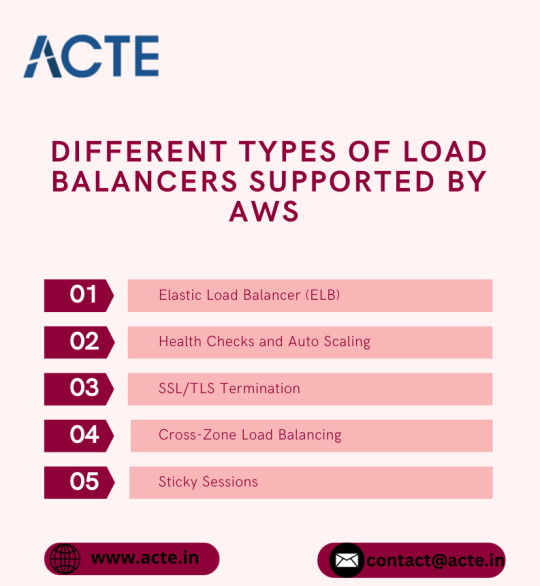
3. SSL/TLS Termination:
Handling SSL/TLS encryption and decryption can be resource-intensive for backend servers. AWS load balancers offer SSL/TLS termination functionality, offloading this computational burden from your resources. With SSL/TLS termination, load balancers can handle the encryption and decryption processes, enhancing performance and simplifying SSL/TLS certificate management.
4. Cross-Zone Load Balancing:
By default, AWS load balancers distribute traffic evenly across all registered resources in different Availability Zones. However, with Cross-Zone Load Balancing, each Availability Zone receives an equal distribution of traffic, regardless of the number of resources in each zone. This ensures optimal utilization of your infrastructure across multiple zones.
5. Sticky Sessions:
Some applications require maintaining session state for users. AWS load balancers support sticky sessions, also known as session affinity. Sticky sessions route requests from a particular client consistently to the same backend resource, preserving session state. This is particularly useful for stateful applications and can enhance performance and user experience.
Load balancing is a critical aspect of building scalable and highly available applications in AWS. With the Elastic Load Balancer (ELB) service, AWS provides a range of load balancing options to suit different application requirements.
Whether you need basic load balancing, advanced routing capabilities, or high-performance handling of heavy traffic loads, AWS load balancers have got you covered. By leveraging these load balancing services, you can optimize your application infrastructure, improve reliability, and deliver a seamless user experience.
Remember, load balancing is not a one-size-fits-all solution. It’s important to evaluate your application’s specific needs and choose the appropriate load balancer type to achieve the desired outcomes.
If you want to learn more about Amazon AWS Course, I highly recommend that you contact ACTE Technologies because they offer certifications and job placement opportunities. Experienced teachers can help you learn better. You can find these services both online and offline. Take things step by step and consider enrolling in a course if you’re interested.
0 notes
Text
Migrating Your AWS Applications, Data, and Databases in Real Time: A Step-by-Step Guide
Migrating your AWS applications, data, and databases in real time can be a complex process. However, with careful planning and the right approach, you can achieve a seamless transition while ensuring minimal downtime and data integrity. We will walk you through the step-by-step process of migrating your AWS components in real time.

Step 1: Assess Your Migration Requirements:
Begin by thoroughly assessing your current environment. Identify the applications, data, and databases that need to be migrated and evaluate their dependencies. Consider the complexity, criticality, and compatibility of each component to devise an appropriate migration strategy.
Step 2: Choose the Optimal Migration Method:
AWS offers various migration methods to suit different scenarios. Evaluate options such as AWS Database Migration Service (DMS), AWS Server Migration Service (SMS), or AWS DataSync. Each method has its own strengths and considerations, so select the one that aligns with your specific needs.
Step 3: Plan for High Availability and Scalability:
Ensure high availability and scalability of your applications during the migration process. Utilize AWS services like Amazon EC2 Auto Scaling, Amazon RDS Multi-AZ, and Amazon Aurora Global Database to maintain optimal performance and handle increased traffic. Implement redundancy and failover mechanisms to minimize potential disruptions.
Step 4: Establish Real-Time Data Replication:
Real-time data replication is crucial for maintaining continuous availability during migration. Leverage AWS services like AWS DMS or utilize third-party tools to enable bi-directional data replication between the source and target environments. This ensures that data changes are synchronized in real time.
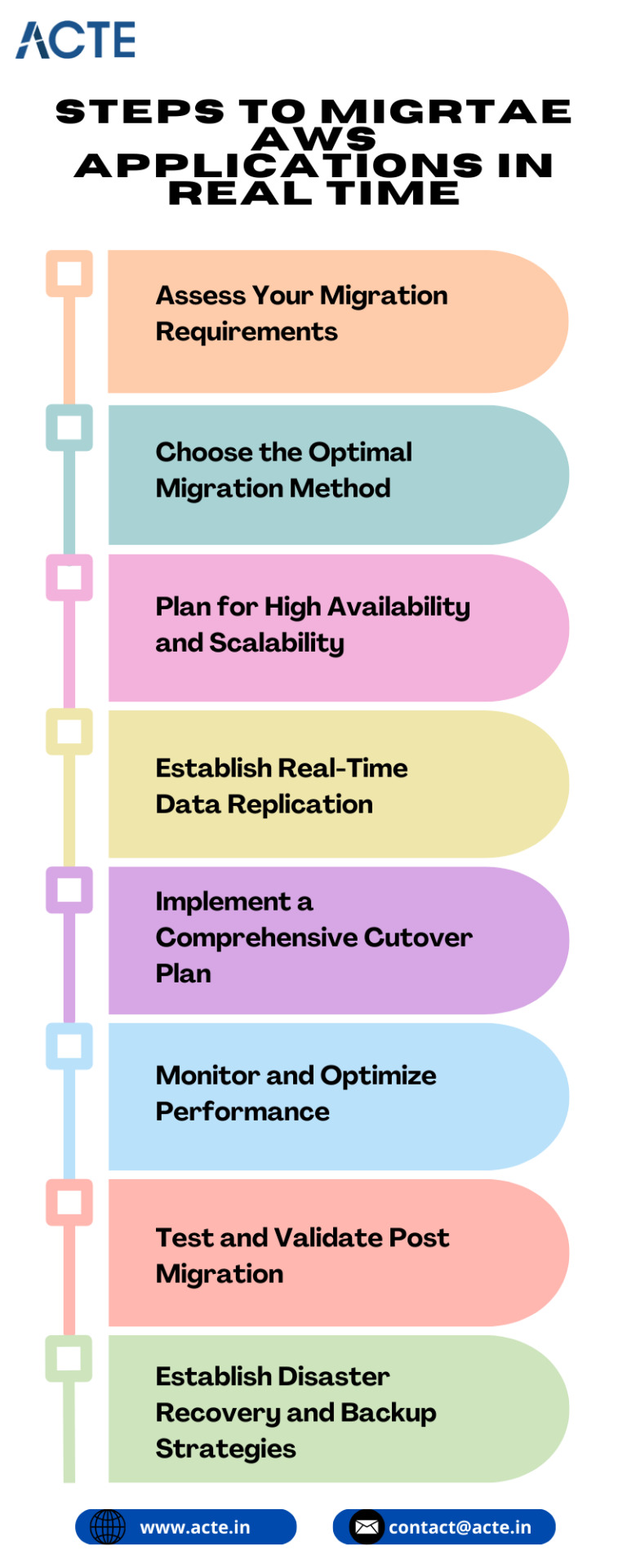
Step 5: Implement a Comprehensive Cutover Plan:
Develop a detailed cutover plan to smoothly transition from the source to the target environment. Include steps for final data synchronization, DNS updates, application switchover, and post-migration functionality verification. Test the plan in a controlled environment to identify and address any potential issues before the actual migration.
Step 6: Monitor and Optimize Performance:
Monitor the performance and health of your applications, data, and databases throughout the migration process. Utilize AWS Cloud Watch to track key metrics, set up alerts, and ensure optimal performance. Continuously optimize your AWS resources by right-sizing instances, optimizing database configurations, and leveraging services like AWS Lambda and Amazon Cloud Front.
Step 7: Test and Validate Post-Migration:
Thoroughly test and validate the functionality of your applications, data, and databases in the new environment. Conduct comprehensive testing, including functional, performance, and security testing, to ensure everything is working as expected. Monitor the post-migration environment closely to identify and address any lingering issues.
Step 8: Establish Disaster Recovery and Backup Strategies:
Ensure robust disaster recovery and backup strategies are in place. Implement automated backup mechanisms, leverage AWS services like AWS Backup, and regularly test your disaster recovery processes to ensure business continuity and data protection.
Migrating your AWS applications, data, and databases in real time requires careful planning, a well-defined strategy, and meticulous execution. By following these step-by-step guidelines, you can achieve a successful migration with minimal disruptions.Remember to assess your migration requirements, choose the right migration method, establish real-time data replication, and thoroughly test and validate the post-migration environment. With proper planning and execution, you can seamlessly migrate your AWS components in real time.
Don’t miss this opportunity to advance your career in the dynamic field of cloud computing!
If you are searching for the AWS course, I recommend exploring the official AWS Training and Certification website at ACTE Technologies. They offer a wealth of resources, including study guides, practice exams, and training courses that cater to different learning styles.
0 notes
Text
Preparation Guide on AWS Certified Advanced Networking — Specialty
Preparing for the AWS Certified Advanced Networking — Specialty Certification requires a structured approach and a combination of resources.

To earn the AWS Certified Advanced Networking — Specialty (ANS-C01) certification, you must first successfully pass the AWS Certified Cloud Practitioner exam. This foundational exam covers fundamental concepts related to AWS cloud computing. Once you have cleared the Cloud Practitioner exam, you can proceed to the Advanced Networking — Specialty exam.
We will present a comprehensive preparation guide that includes an overview of the exam, syllabus, recommended study materials, and valuable tips to help you succeed in the AWS Advanced Networking Specialty exam.
Step-By-Step Guide on How to Prepare for The Certification:
Understand the Exam Blueprint: Start by reviewing the official AWS Certified Advanced Networking — Specialty exam guide. It provides a detailed breakdown of the exam domains, including the percentage weightage for each topic. This will help you understand the areas to focus on during your preparation.
Assess Your Knowledge: Before diving into the material, evaluate your existing knowledge and experience in AWS networking. Identify areas where you feel confident and those that require more attention. This self-assessment will help you plan your study strategy effectively.
Study AWS Documentation and Whitepapers: AWS provides comprehensive documentation and whitepapers on various networking services and architectures. Familiarize yourself with the documentation related to Amazon VPC, Direct Connect, Route 53, Load Balancing, and other relevant topics. Pay attention to recommended best practices and design considerations.
Training Courses and Workshops:AWS offers official training courses specific to the Advanced Networking — Specialty certification. These courses provide in-depth knowledge and hands-on experience with AWS networking services. Attend classroom-based or virtual instructor-led training to enhance your understanding and gain practical skills.
AWS networking services: Attend classroom-based or virtual instructor-led training to enhance your understanding and gain practical skills.
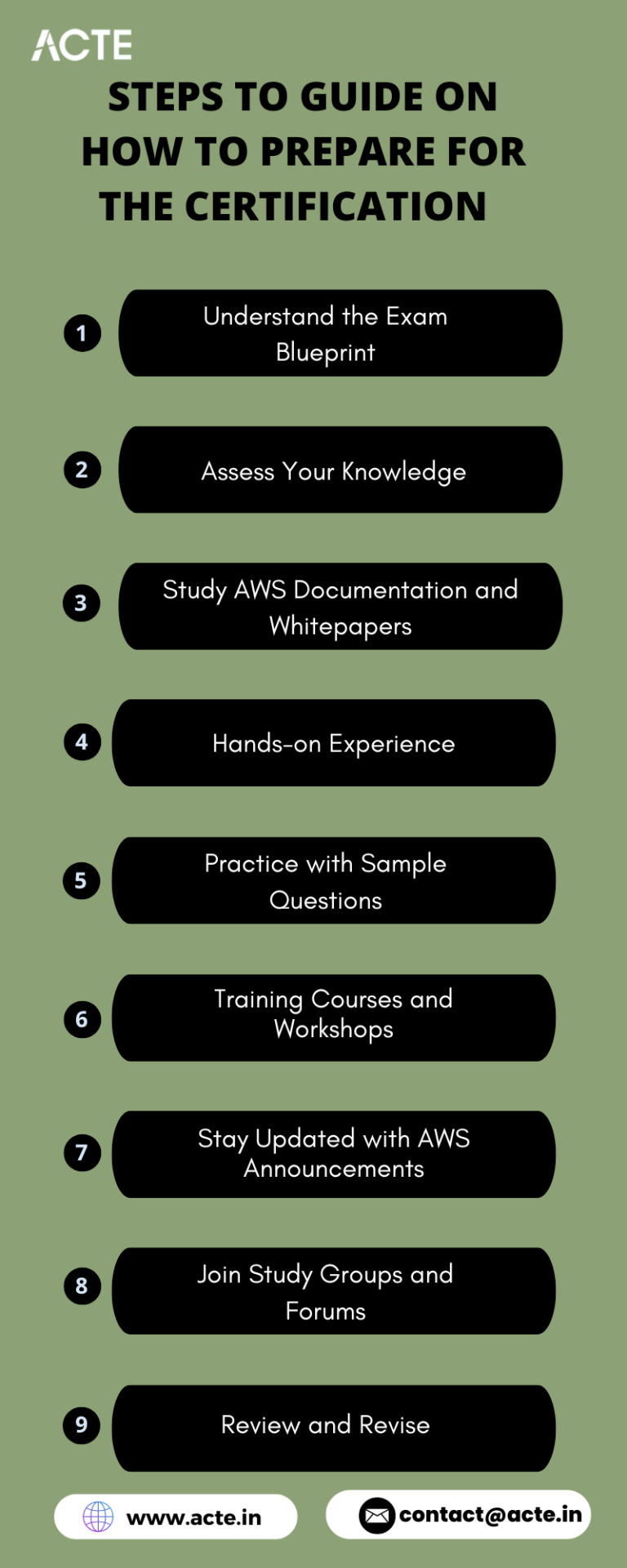
6.Hands-on Experience: Practical experience is crucial for this certification. Create and configure different networking scenarios using AWS services. Practice setting up VPCs, VPN connections, peering relationships, and implementing security controls. Hands-on experience will solidify your understanding of networking concepts and help you troubleshoot real-world scenarios.
7.Practice with Sample Questions: Practice tests and sample questions allow you to assess your knowledge and familiarize yourself with the exam format. AWS provides sample questions on their website, and numerous third-party resources offer practice exams. Analyze your performance and identify weak areas for further study.
Join Study Groups and Forums: Engage with the AWS community by joining online study groups or forums. Discussing concepts, sharing resources, and asking questions can expand your knowledge and provide additional insights. Interacting with peers preparing for the same certification can be motivating and beneficial.
Stay Updated with AWS Announcements: AWS regularly introduces new services, features, and updates. Stay up to date with AWS announcements, blog posts, and re:Invent sessions related to networking. This will help you understand the latest trends and advancements in AWS networking.
Review and Revise: Allocate sufficient time for revision before the exam. Recap the important concepts, review your notes, and revisit any areas where you feel less confident. Focus on understanding the underlying principles and how different AWS services integrate with each other.
Remember to approach your preparation with a balanced mindset, allocate dedicated study time, and practice consistently. By following these steps and leveraging the available resources, you can increase your chances of success in obtaining the AWS Certified Advanced Networking — Specialty Certification.
ACTE Technologies is one of the best AWS training institute in Hyderabad. ACTE Technologies aim to provide trainees with both academic knowledge and hands-on training to maximize their exposure. They are expanding fast and ranked as top notch training institute. Highly recommended. Professional AWS training provider in Chennai. I got certificate from this. For your bright future, get certified now!!
If you want to learn more about the AWS Course, I highly recommend that you contact ACTE Technologies because they offer certifications and job placement opportunities. Experienced teachers can help you learn better. You can find these courses both online and offline.
0 notes
Text
A Comprehensive Guide to Prepare for the AWS Certified SysOps Administrator Certification Exam
If you’re looking to establish a career as a cloud administrator, obtaining the AWS Certified SysOps Administrator certification can significantly boost your credentials and open up new opportunities. This esteemed certification validates your expertise in deploying, managing, and troubleshooting systems in cloud environments.

Understand the Exam Format:
Before diving into your preparation, familiarize yourself with the exam format. The AWS Certified SysOps Administrator exam comprises multiple-choice and multiple-response questions. It evaluates your knowledge across various domains, including monitoring and reporting, deployment and provisioning, security and compliance, automation and optimization, and troubleshooting.
Review the Exam Guide:
The official exam guide provided by AWS is an excellent starting point. This guide outlines the topics covered in the exam, the level of knowledge required for each domain, and the percentage of questions allocated to each area. By thoroughly understanding the exam guide, you can prioritize your study efforts accordingly and better plan your preparation strategy.
Deep Dive into AWS Services:
To succeed in the exam, it is crucial to have a solid understanding of the AWS services that are relevant to the role of a SysOps Administrator. Services such as EC2, S3, RDS, VPC, IAM, CloudWatch, and CloudTrail are commonly covered in the exam. Study their features, configuration options, best practices, and how they integrate with each other. Utilize the extensive AWS documentation, including user guides, FAQs, reference architectures, and whitepapers, to enhance your knowledge.
Gain Hands-On Experience:
Theory alone is not enough; practical experience is vital for success in the AWS Certified SysOps Administrator exam. Utilize the AWS Management Console to interact with the services covered in the exam. Create and manage resources, configure security settings, set up monitoring and alerts, and perform common administrative tasks. The more hands-on experience you gain, the better you’ll understand the practical aspects of the services and their real-world application.
Practice with Sample Questions and Practice Exams:
To assess your knowledge and identify areas that require further study, make use of sample questions and practice exams. Numerous online platforms offer practice tests specifically tailored to the AWS Certified SysOps Administrator exam. Taking these tests will familiarize you with the exam format, improve your time management skills, and help you gauge your readiness for the actual exam.

6. Leverage AWS Training Resources:
AWS provides a wealth of training resources to support your exam preparation. Take advantage of the free online training courses offered by AWS. These courses cover various topics and provide valuable insights into AWS services and best practices. Additionally, explore webinars, whitepapers, and other materials available on the AWS Training and Certification website to supplement your learning.
7. Join Study Groups and Engage with the Community:
Connecting with other professionals preparing for the same certification can be immensely beneficial. Join AWS user groups or online communities to engage in discussions, ask questions, and share insights. Collaborating with others will allow you to gain different perspectives, clarify doubts, and enhance your overall understanding.
8. Stay Updated with AWS:
AWS continuously introduces new services and updates existing ones. Stay updated with the latest developments by regularly reading AWS blogs, attending webinars, and participating in relevant forums. This will ensure that your knowledge remains current and aligned with industry trends.
Preparing for the AWS Certified SysOps Administrator certification exam requires a systematic approach and a combination of theoretical knowledge and hands-on experience.
By following the steps outlined in this guide, including understanding the exam format, deep diving into AWS services, gaining practical experience, leveraging practice exams and training resources, and engaging with the AWS community, you’ll be well on your way to success.
Best of luck on your journey to becoming an AWS Certified SysOps Administrator!
If you are searching for the AWS course, I recommend exploring the official AWS Training and Certification website at ACTE Technologies. They offer a wealth of resources, including study guides, practice exams, and training courses that cater to different learning styles.
0 notes
Text
AWS Dominance in Cloud Computing: Unraveling the Factors Behind their Market Leadership
One name stands out as the undisputed leader — Amazon Web Services (AWS). Despite formidable competitors like Google Cloud Platform and Microsoft Azure, AWS has maintained its dominance in the market.

Key Factors that Have Contributed to Aws’s Overwhelming Success and Market Leadership:

Pioneering Advantage:
AWS holds a significant advantage as a pioneer in the cloud computing market. Launched in 2006, AWS had a head start, allowing them to develop a robust infrastructure, establish a broad range of services, and cultivate strong customer relationships early on.
Breadth and Depth of Services:
One of the core pillars of AWS’s success lies in its extensive portfolio of cloud services. AWS offers a comprehensive suite of services, including compute power, storage, databases, analytics, machine learning, and Internet of Things (IoT). This breadth and depth of offerings cater to the diverse needs of businesses, from startups to large enterprises.
Scalability and Flexibility:
AWS’s ability to scale and adapt to varying demands has been a game-changer for businesses. Their infrastructure allows customers to scale resources based on demand, pay only for what they use, and quickly respond to dynamic market conditions. This scalability and flexibility have empowered businesses of all sizes to leverage AWS’s offerings effectively.
Global Infrastructure:
With a global network of strategically located data centers, AWS has built a formidable infrastructure. Their extensive presence ensures that customers can deploy applications closer to their end-users, reducing latency and improving performance. This global infrastructure effectively supports businesses with a global presence, further solidifying AWS’s market dominance.
Ecosystem and Marketplace:
AWS has fostered a thriving ecosystem of partners, independent software vendors (ISVs), and developers who build and offer services on the AWS platform. This vibrant ecosystem creates a network effect, attracting more customers to AWS due to the availability of a wide range of third-party applications and integrations. The AWS Marketplace further enhances this ecosystem, providing customers with a centralized hub for discovering and procuring additional services.
Reliability and Performance:
AWS has gained a reputation for delivering exceptional reliability, availability, and performance. Their infrastructure is built to handle large-scale workloads and is supported by robust security measures. This reliability and performance have instilled confidence in customers, making AWS the go-to choice for critical and high-performance applications.
Customer Focus:
From the outset, AWS has put customers at the forefront of their operations. They actively listen to customer feedback and continuously improve their services based on their needs. AWS provides extensive documentation, training resources, and dedicated support to help customers succeed in their cloud journey. This customer-centric approach has fostered strong customer loyalty and advocacy.
While formidable competitors like Google Cloud Platform and Microsoft Azure exist, AWS has managed to retain its dominance in the cloud computing market. Through early mover advantage, a comprehensive service portfolio, scalability, a global infrastructure, a thriving ecosystem, reliability, and customer focus, AWS has solidified its market leadership.
However, it’s important to acknowledge that the cloud computing market is dynamic, and competition continues to intensify. The landscape may evolve, and customer preferences may change. Ultimately, the future will be shaped by how AWS and its competitors adapt to emerging trends and deliver value to their customers.
To learn more, You can also check Amazon Web Services Course details at ACTE Technologies.
I hope you enjoy this answer.
Got a question for me? Please mention it in the comments section of this and I will get back to you.
0 notes
Text
A Comprehensive Guide to Passing the AWS Certified Developer Associate Exam
The AWS Certified Developer Associate Exam is a crucial step in establishing your expertise in developing applications on the AWS platform.

Aims to provide you with a comprehensive guide on how to pass the exam successfully.
Some Steps to Increase Your Chances of Achieving the Certification:
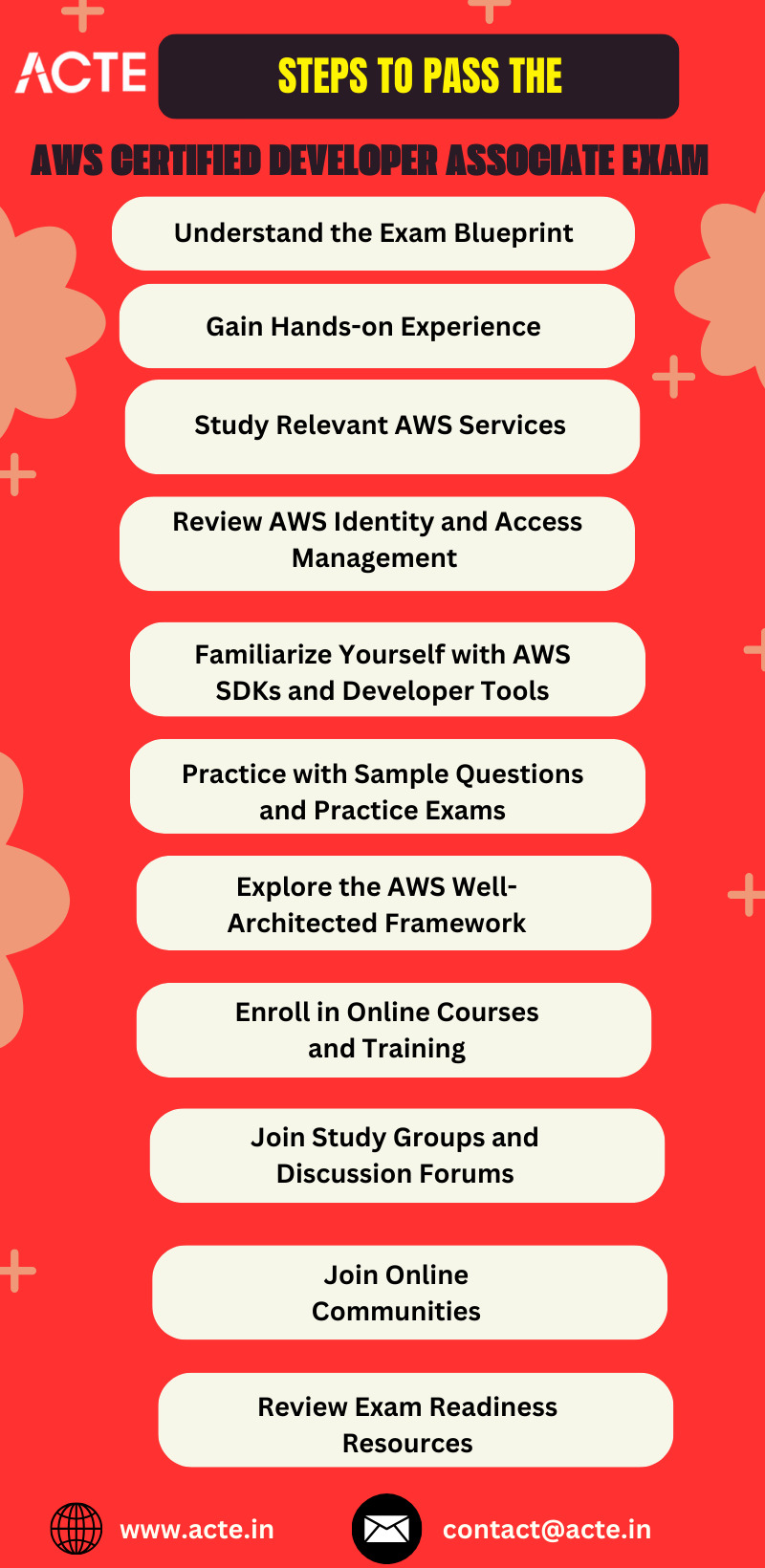
Understand the Exam Blueprint:
To start your preparation, familiarize yourself with the official AWS Certified Developer Associate Exam Guide. This document outlines the exam domains, subtopics, and their weightage. It serves as a roadmap for your study plan, enabling you to focus on the key areas that will be assessed.
Gain Hands-on Experience:
Practical experience is paramount for success in the exam. Create an AWS Free Tier account and immerse yourself in working with various AWS services. Build and deploy applications using services such as EC2, S3, Lambda, DynamoDB, and API Gateway. The more hands-on experience you gain, the better you’ll understand the services and their integration.
Study Relevant AWS Services:
The exam will test your knowledge of various AWS services. Develop a strong understanding of their features, use cases, and best practices. Some of the key services to focus on include EC2, ECS, Lambda, S3, EBS, RDS, DynamoDB, VPC, Route 53, CloudFront, SNS, SQS, Step Functions, EventBridge, CloudFormation, and the AWS SDKs. Dive into the AWS documentation, whitepapers, and FAQs to deepen your knowledge.
Review AWS Identity and Access Management (IAM):
IAM is a critical aspect of AWS security and access management. Understand IAM roles, policies, users, groups, and permissions. Learn how to grant appropriate access to AWS resources while adhering to the principle of least privilege.
Familiarize Yourself with AWS SDKs and Developer Tools:
Gain knowledge of the AWS SDKs available for various programming languages. Understand how to use them to interact with AWS services programmatically. Additionally, explore developer tools like AWS CLI, AWS SAM, and Cloud Formation for infrastructure-as-code deployment.
Practice with Sample Questions and Practice Exams:
Utilize official AWS sample questions and practice exams to assess your knowledge and identify areas that require further study. This exercise will also help you become familiar with the exam format and improve time management skills.
Explore the AWS Well-Architected Framework:
The AWS Well-Architected Framework provides architectural best practices for building reliable, secure, efficient, and cost-effective AWS applications. Understand the five pillars of the framework (Operational Excellence, Security, Reliability, Performance Efficiency, and Cost Optimization) and how they apply to AWS services.
Enroll in Online Courses and Training:
Consider enrolling in online courses specifically designed for the AWS Certified Developer Associate Exam. Platforms like Udemy, A Cloud Guru, and Linux Academy offer comprehensive courses taught by experienced instructors. These courses can provide structured learning and help you grasp complex concepts effectively.
Join Study Groups and Discussion Forums:
Connect with fellow exam takers and AWS professionals in study groups or online forums. Engaging in discussions, sharing resources, and learning from each other’s experiences can significantly enhance your understanding and provide valuable insights.
Review Exam Readiness Resources:
Before the exam, review the official exam readiness resources provided by AWS. These resources include exam guides, whitepapers, and FAQs related to the exam topics. Ensure you are aware of any updates or changes to the exam content.
Passing the AWS Certified Developer Associate Exam requires a combination of theoretical knowledge and practical skills. By following this comprehensive guide, dedicating sufficient time for preparation, and staying updated with the latest AWS services and best practices, you can increase your chances of success. Remember to practice regularly, seek support from study groups, and leverage the available resources.
Good luck on your journey to becoming an AWS Certified Developer Associate!
To learn more, You can also check AWS Course details at ACTE Technologies.
0 notes
Text
10 Tips to Ace Your AWS Certification Exam
Preparing for an AWS certification exam requires a systematic approach and a solid understanding of the AWS services and concepts. With the right strategies and resources, you can increase your chances of passing the exam and validating your AWS expertise.
We’ll provide you with 10 valuable tips and suggestions to help you prepare effectively and confidently for your AWS certification exam.
Master Your AWS Certification Exam: 10 Effective Tips:

Understand the exam blueprint:
Before diving into your study materials, thoroughly review the exam blueprint provided by AWS. This blueprint outlines the topics and domains covered in the exam. Familiarize yourself with the exam structure and weightage of each domain to plan your study strategy accordingly.
Study the official AWS documentation:
AWS offers comprehensive documentation for each service. Dive into this extensive resource to gain a deep understanding of the services, their features, and best practices. Pay attention to the key concepts, architectural patterns, and use cases. The official documentation is often the most reliable and up-to-date source of information.
Take online courses or training:
Enroll in reputable online courses or training programs specifically designed for AWS certification exams. These courses provide structured learning materials, practice exams, and hands-on labs to reinforce your understanding. Look for courses that have received positive feedback from previous learners.
Practice with hands-on experience:
Hands-on experience is crucial for understanding how AWS services work in real-world scenarios. Set up an AWS account and practice creating and managing resources using various services. Experiment with different configurations, explore different use cases, and troubleshoot issues. The more you practice, the better you’ll understand the concepts.
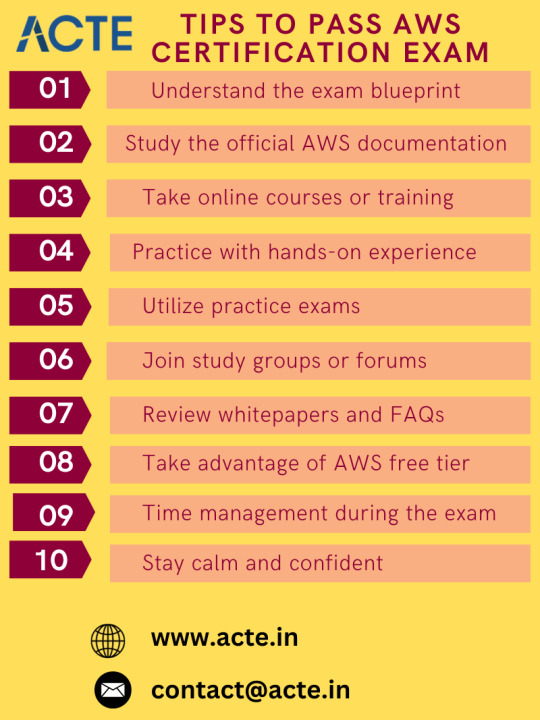
Utilize practice exams:
Practice exams are invaluable resources for assessing your knowledge and familiarizing yourself with the exam format. They simulate the actual exam environment and help you identify weak areas that require more attention. Take multiple practice exams to gauge your progress and build confidence.
Join study groups or forums:
Join online study groups, forums, or communities dedicated to AWS certifications. Engaging with others who are also preparing for the same exam can be beneficial. Discussing concepts, sharing resources, and asking questions can enhance your learning experience. Additionally, these communities often provide valuable tips and insights.
Review whitepapers and FAQs:
AWS publishes whitepapers and FAQs that cover various topics related to their services. These documents provide in-depth information and insights. Reviewing them can give you a deeper understanding of specific services and architectural best practices. Pay attention to the whitepapers listed in the exam blueprint.
Take advantage of AWS free tier:
AWS offers a free tier that allows you to use certain services within specific usage limits for a limited time. Take advantage of this to practice and experiment with AWS services without incurring costs. It’s an excellent opportunity to gain hands-on experience and apply your theoretical knowledge.
Time management during the exam:
Time management is crucial during the exam. Read the questions carefully, eliminate obviously incorrect answers, and flag questions you’re unsure about to revisit later. Don’t spend an excessive amount of time on a single question. Pace yourself and allocate time for reviewing your answers before submitting the exam.
Stay calm and confident:
Lastly, stay calm and confident during the exam. Trust your preparation and the knowledge you’ve acquired. If you come across a difficult question, take a deep breath, analyze the options, and choose the best answer based on your understanding. Overthinking or second-guessing can lead to mistakes. Believe in yourself and your abilities.
Passing an AWS certification exam requires a combination of theoretical knowledge, practical experience, and exam-specific preparation. By following the tips provided in this blog post, you can develop an effective study plan, gain hands-on experience, and approach the exam with confidence. Remember, preparation is key, so dedicate sufficient time and effort to your studies. Best of luck on your AWS certification journey!
If you want to learn more about the AWS Course, I highly recommend that you contact ACTE Technologies because they offer certifications and job placement opportunities. Experienced teachers can help you learn better. You can find these courses both online and offline.
0 notes
Text
Building a Dynamic Website with AWS Serverless Architecture: A Step-by-Step Guide
We will walk you through the process of creating a dynamic website using AWS serverless architecture. By utilizing AWS Lambda, Amazon API Gateway, and Amazon S3, you can build a scalable, cost-effective, and highly available web application.

Whether you’re new to AWS or already familiar with its services, this guide will provide you with the necessary steps to get started.
Building a Dynamic Website with AWS Serverless Architecture: A Step-by-Step Guide:
Prerequisites:

Step 1: Setting up an S3 Bucket for Hosting Static Content
Begin by creating an S3 bucket and enabling static website hosting.
Upload your static files, including HTML, CSS, JavaScript, and other relevant assets, to the S3 bucket.
Step 2: Creating AWS Lambda Functions
Identify the dynamic functionality you wish to implement on your website.
Create AWS Lambda functions using your preferred programming language to handle the required dynamic functionality, such as database interactions or form submissions.
Step 3: Configuring Amazon API Gateway
Create an Amazon API Gateway instance.
Configure API Gateway resources and methods to define the endpoints for your website.
Integrate the API Gateway with your Lambda functions to enable the invocation of functions upon request.
Step 4: Configuring API Gateway as a Reverse Proxy
Configure API Gateway to act as a reverse proxy, effectively routing requests to the appropriate resources based on the URL path.
Ensure the necessary API Gateway settings, such as request and response mappings, are properly defined.
Step 5: Testing and Deployment
Deploy your static content to the S3 bucket for hosting.
Thoroughly test the dynamic functionality of your website using the API Gateway.
Make any required updates and redeploy as necessary.
By following these step-by-step instructions, you can successfully create a dynamic website using AWS serverless architecture. Taking advantage of services like AWS Lambda, Amazon API Gateway, and Amazon S3 allows you to build web applications that are scalable, cost-effective, and highly available.
Should your website require additional functionality, consider exploring services like Amazon DynamoDB or AWS Amplify. Remember, building a serverless website may involve some complexity, so it’s advisable to refer to tutorials and documentation to enhance your understanding of the concepts discussed in this blog post.
We hope this guide provides you with the knowledge and confidence to embark on your journey of building dynamic websites on AWS. Happy coding!
To learn more, You can also check AWS Course details at ACTE Technologies.
0 notes
Text
A Comprehensive Guide to Prepare for AWS Certified Cloud Practitioner Level Certification
The AWS Certified Cloud Practitioner certification is an entry-level credential offered by Amazon Web Services (AWS) that validates your understanding of the AWS Cloud and foundational cloud concepts. This certification is ideal for individuals who are new to AWS and want to establish a solid foundation in cloud computing.

The AWS Certified Cloud Practitioner certification is designed for individuals new to AWS, seeking to establish a strong foundation in cloud computing.
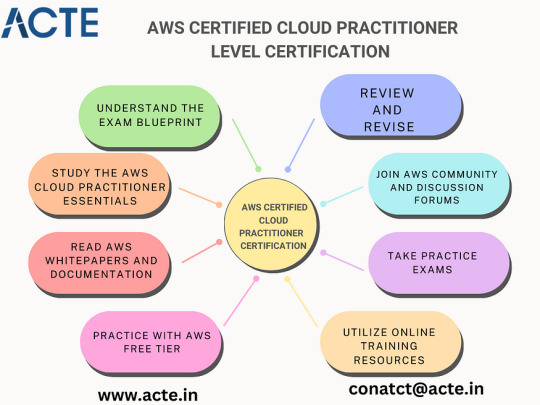
Familiarize Yourself with The Exam Blueprint:
Start by understanding the exam blueprint, which outlines the domains and topics covered in the AWS Certified Cloud Practitioner exam. This will provide you with a clear roadmap for your study plan.
Study AWS Cloud Practitioner Essentials:
Begin your preparation with the free training course provided by AWS called “AWS Cloud Practitioner Essentials.” This course covers fundamental AWS Cloud concepts, services, security, architecture, pricing, and support, laying a solid foundation for your understanding.
Explore AWS Whitepapers and Documentation:
Dive into AWS whitepapers and documentation, which offer valuable insights into AWS services and best practices. Familiarize yourself with resources such as the “AWS Well-Architected Framework,” “AWS Security Best Practices,” and “Overview of Amazon Web Services” to deepen your knowledge.
Gain Hands-on Experience with AWS Free Tier:
Leverage the AWS Free Tier to practice using various AWS services without incurring any charges. Experiment with launching EC2 instances, creating S3 buckets, configuring security groups, and exploring other services. Practical experience will enhance your understanding and retention of key concepts.
Utilize Online Training Resources:
Make the most of online training resources available on platforms like A Cloud Guru, Udemy, and Linux Academy. These platforms offer comprehensive study materials, including video lectures, practice exams, quizzes, and study guides. Choose resources that align with your learning style and budget.
Test Your Knowledge with Practice Exams:
Take advantage of free and paid practice exams tailored for the AWS Certified Cloud Practitioner exam. These practice exams simulate the real exam environment, allowing you to assess your knowledge, identify areas for improvement, and get familiar with the question format. Review explanations for incorrect answers to strengthen your understanding.
Engage with AWS Community and Discussion Forums:
Join AWS-focused community forums, discussion boards, and social media groups. Connect with fellow learners, ask questions, and share insights. The AWS community is known for its supportive nature and willingness to help aspiring professionals.
Review and Consolidate:
Allocate dedicated time for reviewing and reinforcing your knowledge. Focus on areas where you feel less confident, practice with sample questions, and engage in hands-on exercises. Consider using flashcards or creating summary notes to summarize key concepts.
By following this comprehensive guide, you can effectively prepare for the AWS Certified Cloud Practitioner exam. Remember to familiarize yourself with the exam blueprint, study the essential resources, gain hands-on experience, utilize online training materials, take practice exams, engage with the AWS community, and review and consolidate your knowledge.
Best of luck on your journey to becoming an AWS Certified Cloud Practitioner!
ACTE Technologies to offer comprehensive and effective training across various technology-related fields. Studying AWS Course at ACTE Technologies provides a dynamic and engaging learning experience that taps into the collective knowledge and enthusiasm of participants, making it an efficient.
0 notes
Text
Exploring Migration Options for SAP Workloads on AWS
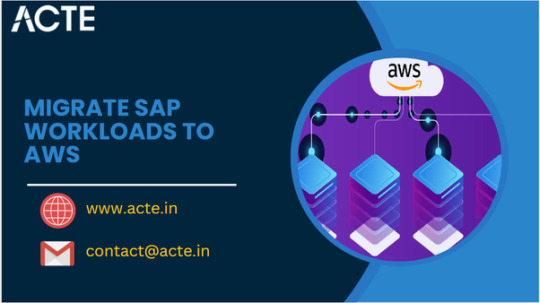
Amazon Web Services (AWS) offers a range of options and services to facilitate the migration of SAP applications and databases.
Migration Options Available for Sap Workloads on Aws:
AWS Server Migration Service (SMS):
AWS Server Migration Service (SMS) simplifies the migration of on-premises SAP environments to AWS. It automates server replication and orchestration, enabling a seamless migration of SAP systems with minimal downtime or disruption. SMS supports both homogeneous and heterogeneous migrations (same or different database vendors).
AWS Database Migration Service (DMS):
To migrate SAP databases to AWS, the AWS Database Migration Service (DMS) proves to be invaluable. DMS supports both homogeneous and heterogeneous database migrations, enabling the movement of SAP databases to Amazon RDS, Amazon Aurora, or Amazon EC2 instances running SAP HANA or other database engines.
SAP Rapid Migration Test Program:
The SAP Rapid Migration Test Program (RMTP) is a collaborative effort between AWS and SAP, offering guidance and support for SAP workload migration to AWS. Through this program, customers gain access to resources, tools, and expertise necessary for planning, executing, and validating SAP workload migrations.
AWS Partner Solutions:
Leveraging the extensive AWS partner ecosystem, including SAP-certified partners, can simplify SAP workload migrations. These partners provide migration tools, expertise, and services tailored for migrating SAP workloads to AWS. Collaborating with these partners ensures smooth migration processes and successful outcomes.
AWS Snowball and AWS Snowball Edge:
For large-scale SAP migrations with restricted network bandwidth or high data transfer costs, AWS Snowball and AWS Snowball Edge devices can be utilized. These physical devices enable secure offline data migration by shipping them to your location, overcoming limitations associated with network-based transfers.
Lift and Shift or Replatforming:
When migrating SAP workloads to AWS, two strategies can be employed: lift and shift or replatforming. Lift and shift involve moving SAP workloads to AWS with minimal modifications, while replatforming optimizes SAP applications to leverage AWS native services, such as Amazon EC2, Amazon S3, or AWS Lambda.

Migrating SAP workloads to AWS offers numerous benefits, and AWS provides a diverse range of options and services to support successful migrations.
Whether utilizing AWS Server Migration Service, AWS Database Migration Service, SAP Rapid Migration Test Program, partner solutions, physical devices like AWS Snowball, or adopting lift and shift or replatforming strategies, meticulous planning and execution are key to a seamless and efficient migration process.
By leveraging available resources and expertise, businesses can accelerate SAP workload migrations to AWS and unlock the full potential of cloud computing.
If you want to learn more about the AWS Course, I highly recommend that you contact ACTE Technologies because they offer certifications and job placement opportunities. Experienced teachers can help you learn better. You can find these courses both online and offline.
0 notes
Text
Advancing Your Career with AWS Certifications: A Path to Success

These certifications validate your expertise in AWS technologies and open doors to new opportunities for professional growth. We will explore effective strategies to advance your career using AWS certifications.
Expand Your Knowledge and Skills:
AWS certifications require a deep understanding of AWS services, best practices, and architectural concepts. By obtaining certifications, you not only enhance your knowledge but also develop practical skills in cloud computing. This expertise sets you apart in your current role and increases your value as an employee.
Stand Out in the Job Market:
In a fiercely competitive job market, AWS certifications differentiate you from other candidates. Employers highly regard certified professionals as they demonstrate a commitment to continuous learning and possess the necessary skills to work effectively with AWS technologies. Highlighting your AWS certifications on your resume attracts the attention of recruiters and hiring managers.
Unlock Career Advancement Opportunities:
AWS certifications unlock new avenues for career advancement, both within your current organization and in the broader job market. Certifications can position you for roles such as AWS Solutions Architect, DevOps Engineer, Cloud Security Specialist, or Cloud Consultant. These positions often come with increased responsibilities, greater visibility, and higher earning potential.
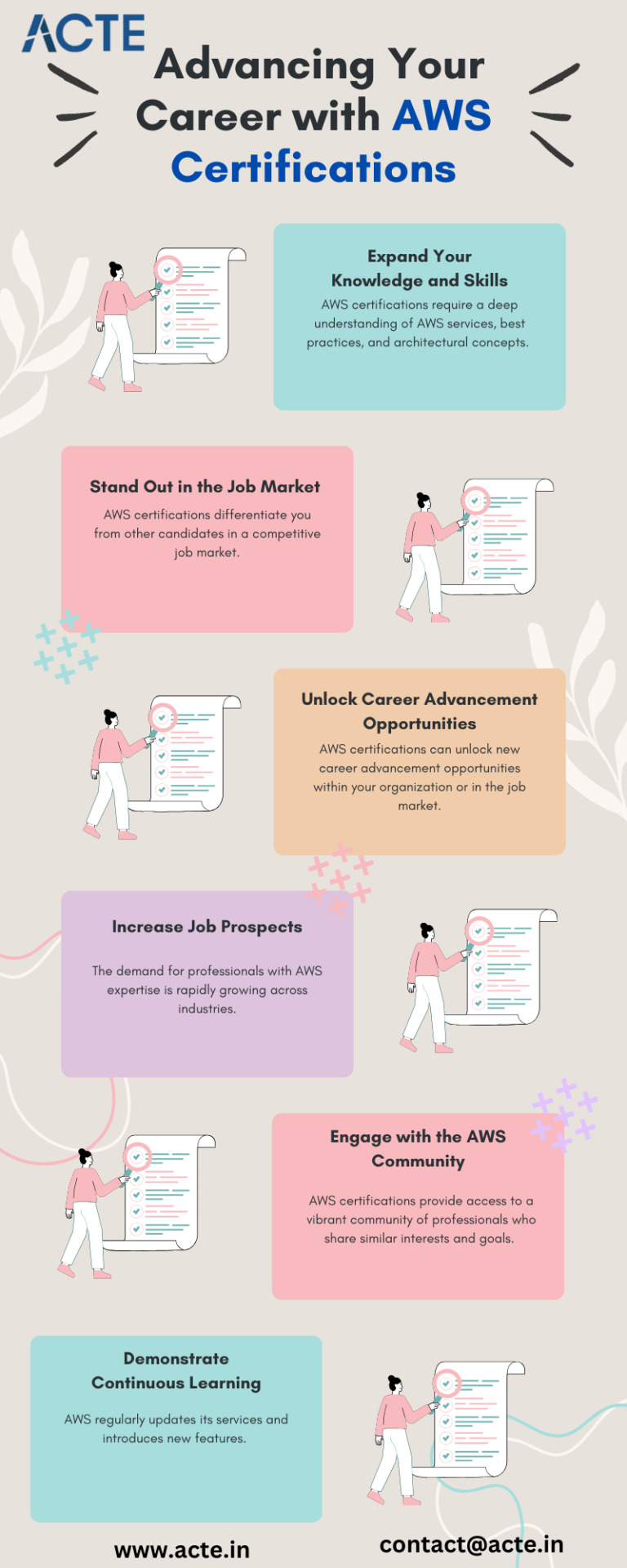
4. Expand Your Job Prospects:
The demand for professionals with AWS expertise is rapidly growing across industries. Holding AWS certifications broadens your job prospects and grants access to a wide range of opportunities. Many organizations actively seek AWS-certified professionals to design, implement, and manage their cloud infrastructure. Your AWS certifications make you a highly desirable candidate for such roles.
5. Engage with the AWS Community:
AWS certifications provide access to a vibrant community of professionals who share similar interests and goals. Engaging with this community expands your professional network, fosters knowledge sharing, and encourages collaboration. Actively participating in industry events, forums, and online communities keeps you updated on the latest trends and developments within the AWS ecosystem.
6. Demonstrate Continuous Learning:
AWS services evolve continuously, with new features and updates regularly introduced. Maintaining your AWS certifications requires staying current with these advancements and embracing best practices. Demonstrating a commitment to continuous learning showcases your professional growth and adaptability, making you a valuable asset to employers and opening doors to challenging and rewarding projects.
AWS certifications are powerful assets that can propel your career in the dynamic field of cloud computing. By expanding your knowledge, standing out in the job market, unlocking career advancement opportunities, broadening your job prospects, engaging with the AWS community, and demonstrating a commitment to continuous learning, you can maximize the benefits of your AWS certifications and achieve remarkable professional growth.
Combine your certifications with practical experience to reinforce your skills and enhance your career prospects. Embrace the opportunities that AWS certifications offer and embark on a rewarding journey toward success in cloud computing.
If you want to learn more about the AWS Course, I highly recommend that you contact ACTE Technologies because they offer certifications and job placement opportunities. Experienced teachers can help you learn better. You can find these courses both online and offline.
0 notes
Text
Exploring the Different Types of AWS Security Certifications

AWS offers a range of security certifications designed to validate and demonstrate individuals’ skills and knowledge in securing AWS environments.
Amazon Web Services (AWS) offers the following security certifications:
AWS Certified Security — Specialty:
The AWS Certified Security — Specialty certification validates the knowledge and skills required to secure AWS workloads. It covers various security topics such as identity and access management, data protection, incident response, infrastructure security, and more. This certification is intended for individuals who have a deep understanding of AWS security services and best practices.
AWS Certified Advanced Security — Specialty:
The AWS Certified Advanced Security — Specialty certification is an advanced-level certification that focuses on advanced security concepts and practices specific to AWS. It validates expertise in areas such as advanced threat detection, incident response, security automation, and architectural best practices for securing AWS environments. This certification is suitable for individuals with extensive experience in implementing and managing security controls in AWS.
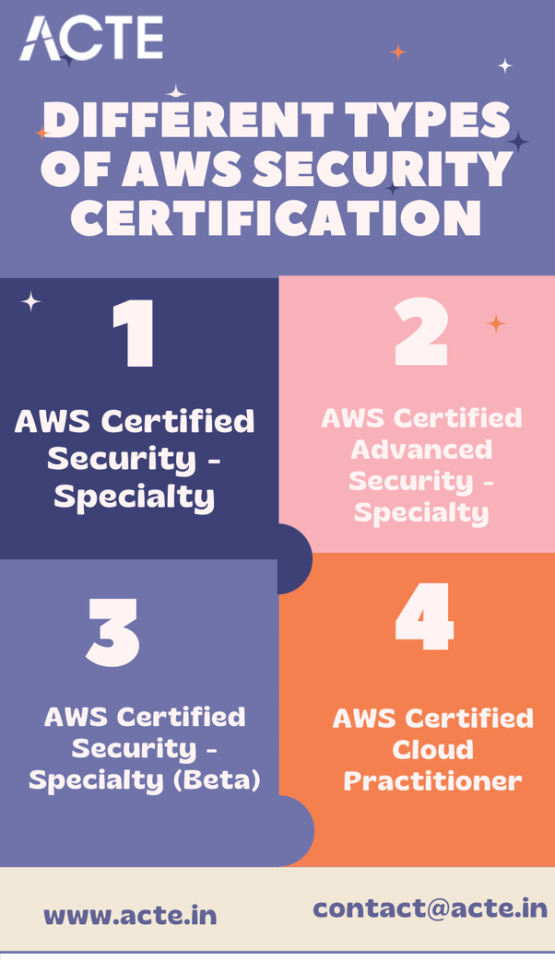
3. AWS Certified Security — Specialty (Beta):
The AWS Certified Security — Specialty (Beta) certification is an optional beta-level certification that provides individuals with an opportunity to be among the first to earn the newest AWS security certification. It is designed to validate skills and knowledge in securing AWS workloads using the latest services and features available on the AWS platform. As a beta certification, it may have limited availability and may undergo updates and modifications based on feedback from participants.
4. AWS Certified Cloud Practitioner:
While not exclusively focused on security, the AWS Certified Cloud Practitioner certification provides a broad understanding of AWS Cloud and its security aspects. It covers the basics of AWS services, security best practices, compliance frameworks relevant to AWS, and more. This certification is suitable for individuals who are new to AWS and want to establish a foundational understanding of cloud computing and security.
As the demand for secure cloud environments continues to rise, obtaining AWS security certifications can significantly enhance career prospects in the field of cloud computing. The various AWS security certifications, such as AWS Certified Security — Specialty and AWS Certified Advanced Security — Specialty, validate individuals’ expertise in securing AWS workloads and demonstrate their ability to implement robust security measures.
Additionally, the AWS Certified Cloud Practitioner certification provides a fundamental understanding of AWS security concepts. By obtaining these certifications, professionals can showcase their skills to potential employers and establish themselves as trusted experts in AWS security.
Save hundreds of hours by learning from working professionals with the best AWS training in Chennai. Right team for your training needs.
Don’t waste time thinking, it’s time to act. Contact ACTE Technologies for more details.
0 notes
Text
Exploring the Pros and Cons of Using AWS EC2 Instances for Web Development
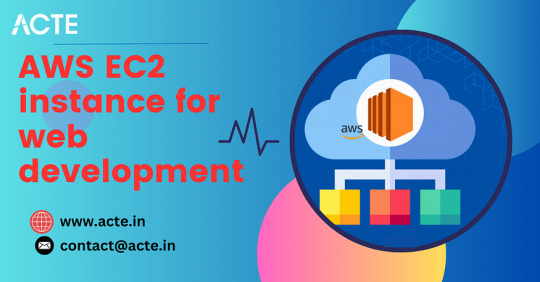
We will delve into the pros and cons of using AWS EC2 instances for web development, helping you make an informed decision for your development needs.
Advantages and Disadvantages of using an AWS EC2 instance for web development:
Advantages:
Scalability: AWS EC2 instances provide the flexibility to scale your resources up or down based on the demand of your web application. This allows you to handle peak traffic periods efficiently and avoid overprovisioning or under provisioning your infrastructure.
Customization: EC2 instances offer a wide range of configuration options, allowing you to choose the instance type, operating system, storage options, and networking settings that best suit your specific web development needs. You have full control over the software stack and can install any libraries, frameworks, or tools required for your development environment.
Security: AWS provides a robust set of security features for EC2 instances. You can leverage security groups, network ACLs, and AWS Identity and Access Management (IAM) to control access to your instances. Additionally, you can enable encryption for data at rest and in transit, use AWS Web Application Firewall (WAF) for protection against common web exploits, and implement other security measures to safeguard your web applications.
Reliability: AWS maintains a highly available infrastructure, ensuring that your EC2 instances are accessible and reliable. EC2 instances can be distributed across multiple Availability Zones (AZs) within a region, providing redundancy and fault tolerance. You can also utilize AWS Elastic Load Balancing to distribute traffic across multiple instances, further enhancing availability.
Cost-effective options: AWS offers various pricing options for EC2 instances. You can choose to pay for instances on a per-hour basis (on-demand instances), reserve instances for a longer duration at a discounted rate (reserved instances), or use spot instances to bid on spare AWS capacity at lower prices. This flexibility allows you to optimize costs based on your usage patterns and budget.

Disadvantages:
Technical expertise required: Setting up and managing EC2 instances requires a certain level of technical expertise. You need to be familiar with AWS services, networking concepts, security configurations, and server administration. If you are new to AWS, there may be a learning curve to overcome.
Cost management: While EC2 instances offer cost-effective options, it’s important to monitor and manage your usage to avoid unexpected costs. Forgetting to stop or terminate instances when not in use can lead to unnecessary charges. Additionally, the complexity of AWS pricing models can make it challenging to estimate and control expenses accurately.
Maintenance and updates: EC2 instances require regular maintenance, including applying security patches, updating software packages, and managing backups. You are responsible for ensuring that your instances are up to date and secure, which adds to the operational overhead.
Complexity of AWS services: AWS has a vast ecosystem of services, and navigating through the various options and configurations can be overwhelming, especially for beginners. It may take time to understand how different services integrate and work together to build a robust web development environment.
It’s important to weigh these advantages and disadvantages based on your specific requirements and expertise when considering AWS EC2 for web development.
If you are searching for the AWS course, I recommend exploring the official AWS Training and Certification website at ACTE Technologies. They offer a wealth of resources, including study guides, practice exams, and training courses that cater to different learning styles.
0 notes
Text
Exploring the Pros and Cons of Amazon Web Services (AWS) as a Hosting Provider
I am very happy to answer your question regarding AWS.

Advantages of AWS:
Scalability: AWS provides the ability to scale resources up or down based on demand. This allows businesses to easily accommodate fluctuations in website traffic or application usage without worrying about hardware limitations.
Flexibility: AWS offers a vast array of services and configurations, allowing businesses to choose the most suitable options for their specific needs. It supports various operating systems, programming languages, and databases, providing flexibility in application development and deployment.
Reliability: AWS has a highly reliable infrastructure with multiple data centers located worldwide. It offers built-in redundancy and failover mechanisms to ensure high availability and minimize downtime.
Security: AWS has extensive security measures in place to protect customer data. It provides features such as access controls, encryption, network firewalls, and monitoring tools to enhance the security of hosted applications and data.
Cost-efficient: AWS offers a pay-as-you-go pricing model, allowing businesses to pay only for the resources they use. This eliminates the need for upfront hardware investments and provides cost savings for businesses, especially for those with variable workloads.
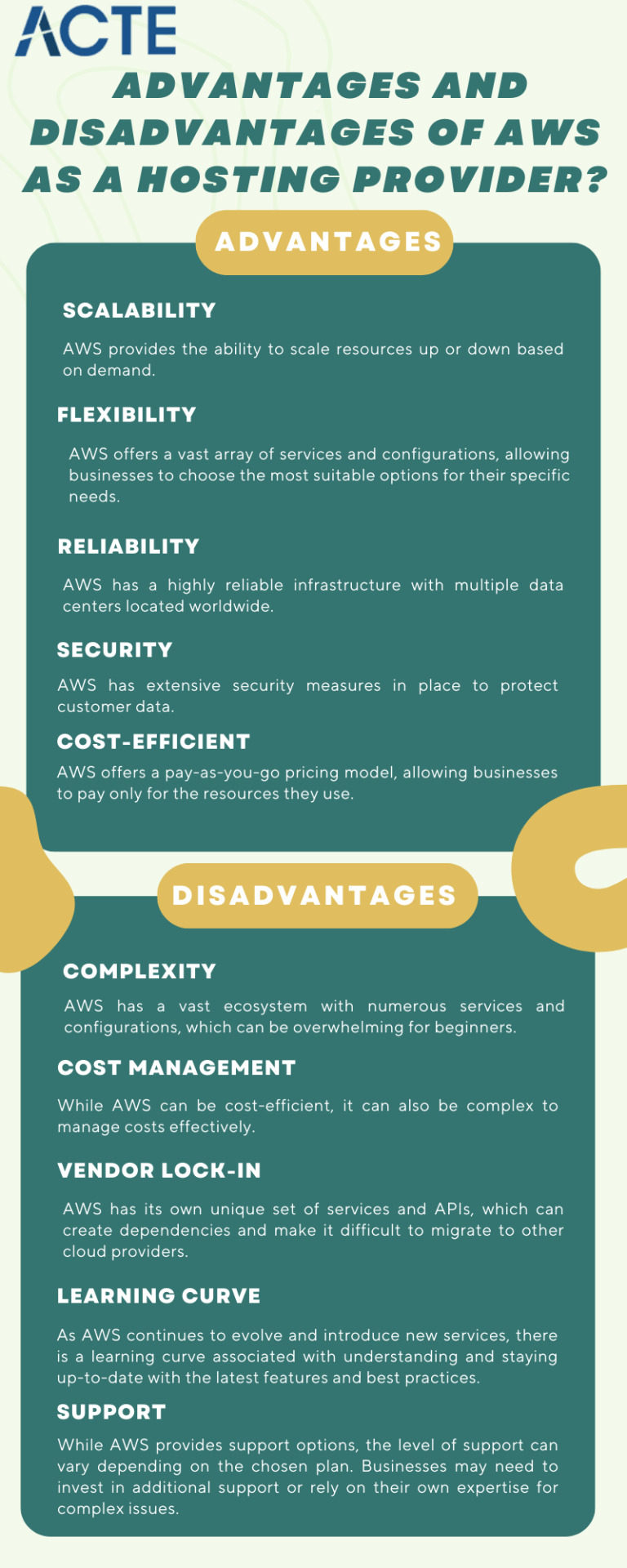
Disadvantages of AWS:
Complexity: AWS has a vast ecosystem with numerous services and configurations, which can be overwhelming for beginners. Managing and configuring the various services require a certain level of technical expertise and understanding.
Cost Management: While AWS can be cost-efficient, it can also be complex to manage costs effectively. With numerous services and pricing options, it can be challenging to estimate and control expenses, leading to unexpected bills if not monitored closely.
Vendor Lock-in: AWS has its own unique set of services and APIs, which can create dependencies and make it difficult to migrate to other cloud providers. This can potentially limit the flexibility of a business to switch providers in the future.
Learning Curve: As AWS continues to evolve and introduce new services, there is a learning curve associated with understanding and staying up-to-date with the latest features and best practices.
Support: While AWS provides support options, the level of support can vary depending on the chosen plan. Businesses may need to invest in additional support or rely on their own expertise for complex issues.
It’s important to evaluate these advantages and disadvantages in the context of your specific requirements and business needs to make an informed decision about using AWS as a hosting provider.
You can enroll in AWS training at ACTE Technologies, where they offer comprehensive programs to help you become proficient in AWS services. These courses cover everything from the basics to advanced topics . ACTE Technologies provides a structured and hands-on learning experience, allowing you to gain practical skills for various purposes.
0 notes
Text
Salary Insights for AWS Certified Developers
As the demand for cloud computing continues to rise, professionals with expertise in Amazon Web Services (AWS) are highly sought after in the job market. AWS certifications validate an individual's proficiency in utilizing AWS services effectively.

One common question that arises is, "What is the salary for an AWS certified developer?" In this blog post, we will delve into the factors influencing AWS certified developer salaries and provide insights into the average compensation levels.
Factors Impacting AWS Certified Developer Salaries:
a. Experience: The number of years of experience a developer possesses plays a significant role in salary determination. Junior or entry-level positions may offer salaries ranging from $70,000 to $90,000 per year, while senior developers with extensive experience can earn over $150,000 annually.
b. Location: Salaries can vary based on the geographical location. Tech hubs like San Francisco, Seattle, New York City, and Boston often provide higher salaries due to increased demand and a higher cost of living. Conversely, areas with a lower cost of living may offer comparatively lower salaries.

c. Certification Level: AWS provides different certification levels, such as the AWS Certified Developer - Associate and AWS Certified Developer - Professional. Higher-level certifications generally command higher salaries due to their advanced skill requirements and the value they bring to organizations.
d. Industry and Company Size: The industry and company size also influence salaries. Tech companies, startups, and industries like finance, healthcare, and e-commerce with critical technology infrastructure tend to offer competitive salaries to AWS certified developers.e. Additional Skills: Proficiency in additional programming languages, frameworks, or tools commonly used with AWS, such as Python, Java, or Docker, can further impact salary negotiations.
Average Salary Range for AWS Certified Developers:
According to Glassdoor data from 2021, the average salary for an AWS certified developer in the United States is approximately $110,000 per year. However, it is important to note that this figure is an average, and actual salaries can vary based on the factors mentioned above.
Becoming an AWS certified developer can open up numerous career opportunities and competitive salaries. The salary range for AWS certified developers can vary widely based on factors such as experience, location, certification level, industry, company size, and additional skills. It is advisable to research the current salary trends in your specific location and industry to obtain the most accurate and up-to-date information.
Note: Salary figures provided are approximate averages and subject to change. It is recommended to refer to recent salary surveys and job market data for the most accurate and current salary information.
To learn more, You can also check Amazon Web Services Course details at ACTE Technologies.
0 notes
Text
Exploring the Genesis of Aws:

Jeff Bezos and the Birth of AWS
In the early 2000s, Amazon.com was experiencing significant growth as an e-commerce platform. However, the company had built a robust infrastructure to support its operations, including data centers and server farms. Jeff Bezos realized that this infrastructure could be leveraged to provide cloud computing services to external customers.
The Launch of AWS

The Growth and Expansion of AWS
AWS quickly gained traction in the market, attracting customers from startups to large enterprises. The platform’s scalability, reliability, and cost-effectiveness made it an attractive choice for businesses looking to leverage the power of the cloud. Over the years, AWS continued to expand its service offerings, introducing new services such as artificial intelligence, machine learning, and Internet of Things (IoT).
The Impact of AWS
AWS has had a profound impact on the technology industry. It has democratized access to computing resources, allowing businesses of all sizes to innovate and scale their operations without the need for significant upfront investments. AWS has also played a crucial role in enabling the growth of startups and the digital transformation of established companies.
By leveraging their existing infrastructure, they created a cloud computing platform that has revolutionized the way businesses operate and paved the way for the digital age. Today, AWS continues to innovate and expand its services, driving the adoption of cloud computing worldwide.
If you are searching for the AWS course, I recommend exploring the official AWS Training and Certification website at ACTE Technologies. They offer a wealth of resources, including study guides, practice exams, and training courses that cater to different learning styles.
0 notes
Text
DevOps vs. AWS: Apples and Oranges of the Tech World
In the ever-evolving landscape of technology and business operations, it’s not uncommon for people to compare and contrast two seemingly different concepts, sometimes leading to questions like, “Which is better, DevOps or AWS?” But here’s the catch: comparing DevOps and AWS is a bit like comparing apples and oranges. They serve different purposes, and their value is context-dependent.
We’ll delve into the distinctions between DevOps and AWS, helping you understand their roles and how they can work in harmony to optimize your technology and business operations.
DevOps: The Methodology of Collaboration and Efficiency
DevOps is a culture, a set of practices, and a mindset that bridges the gap between software development and IT operations. It aims to create a seamless and collaborative environment, where development and operations teams work together throughout the software development lifecycle. The primary goals of DevOps are automation, faster delivery, and continuous improvement.
In a DevOps culture, you’ll find practices such as Continuous Integration (CI) and Continuous Delivery (CD), which automate the build, test, and deployment phases of software development. The emphasis is on streamlining processes, reducing errors, and fostering a culture of shared responsibility.
AWS: The Cloud Powerhouse
On the other hand, AWS, or Amazon Web Services, is a leading cloud computing platform offering a vast array of cloud services. These services encompass computing power, storage, databases, machine learning, analytics, and much more. AWS provides the infrastructure and services required for hosting applications, managing data, and running various workloads in the cloud.
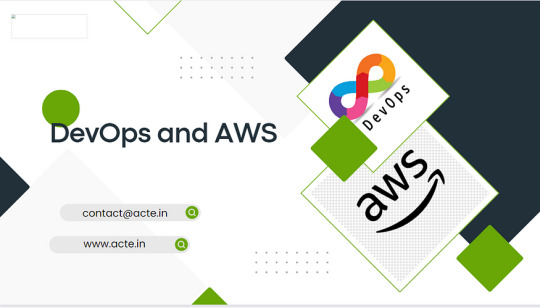
Apples and Oranges: Comparing the Incomparable
So, back to the question of which is better, DevOps or AWS? The answer depends on your needs and context.
If you’re seeking to enhance your software development and deployment processes, DevOps is the way to go. Implementing DevOps practices can be transformative. It reduces the friction between development and operations, automates repetitive tasks, and ultimately speeds up software delivery.
If you require a cloud platform to host your applications, data, or other services, AWS is a top contender. With its vast range of services, you can scale your infrastructure up or down, ensuring reliability, security, and high availability.
The Harmony of DevOps and AWS:
But why choose one when you can have both? DevOps and AWS are not mutually exclusive. In fact, they often complement each other beautifully.
DevOps practices can be applied to efficiently manage applications and workloads hosted on AWS. With CI/CD pipelines, automated testing, and infrastructure as code, you can optimize your deployment processes on the AWS platform.
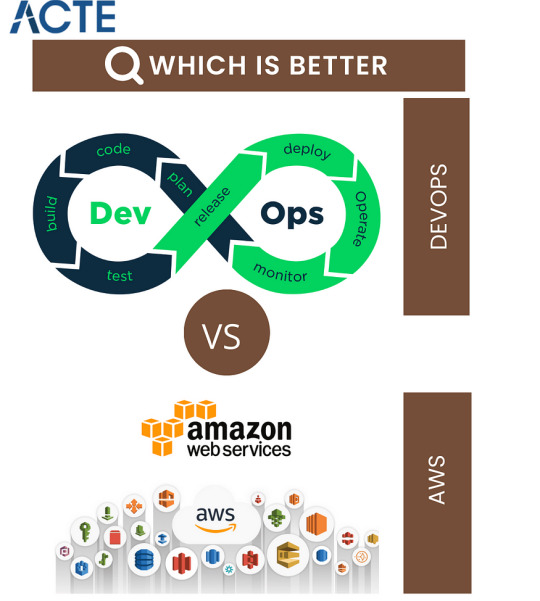
In essence, DevOps and AWS are two pieces of a larger puzzle. They aren’t better or worse than each other; they simply have different roles. DevOps is the methodology for streamlining your software development and deployment, while AWS is the cloud powerhouse offering scalable infrastructure and services. Together, they can supercharge your technology and business operations.
Don’t choose between DevOps and AWS; choose both, and let them work together in harmony to propel your organization into a more efficient, scalable, and competitive future.
ACTE Technologies provide AWS cloud training course at affordable prices. Develop cloud skills in AWS certification. They are offering job assured training courses to students to get the job opportunities in top notch companies.
0 notes